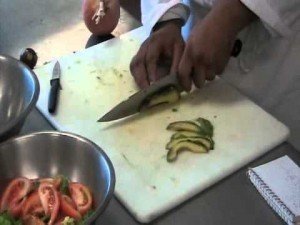There are many types of salad and most of them aren’t served before your meal. In “meat and potatoes” America, the salad is served first, followed by the main entrée. This isn’t the way in many parts of the world.
Actually, a salad can be served with any meal, any time of the day. But there are guidelines for making an excellent salad, just like any basic cooking method. Although, salads are not cooked so we can’t depend on heat to combine and change flavors in a salad.
Using the freshest ingredients is critical in making a great salad. All the items in your salad are obvious to the diner so their color, texture, and appearance are really on display. Just as we discussed in a previous class, How To Make Salad Dressings With 3 Ingredients , salad dressings aren’t cooked either so the best ingredients lead directly to the best results.
A salad is defined as “any single food or mix of different foods accompanied or bound by a dressing”. A salad can contain meat, grains, fruits, nuts or cheese and absolutely no lettuce.
It can be an appetizer, a second course served after the appetizer, an entrée, a course following the entrée in the European manner, or even a dessert.
The color, texture and flavor of each salad ingredient should complement those of the others, and the dressing should complement all of the ingredients. Harmony is critical to a salad’s success, no matter what type of salad is being prepared.
The types of salad are classified by what course they serve.
1) Appetizer Salads – were originally created to ease the pressure on the kitchen from elaborate first courses. The wait staff usually made salads to keep the cool ingredients out of the hot kitchen.
Appetizer salads give the diner satisfying food while the entrée is prepared and should stimulate the appetite with fresh, crisp ingredients and attractive/appetizing appearance without being so large as to be filling. The combination of ingredients should be interesting, not dull to all the senses.
Tossed greens salads are most often used as appetizers because they are bulky without being filling. The goal of serving a salad before the meal is to arrange an attractive display and have the eye stimulate the appetite.
2) Accompaniment Salads – are usually served along with the main course. They serve the same function as other side dishes and sit on the same plate and the entrée, so they must harmonize and balance with the rest of the meal.
This type of salad should be light and flavorful, not too rich to overpower the featured item. You’d never serve chicken salad along with a steak, so an accompaniment salad can be understated in ingredients, but not in flavor or appearance.
3) Main Course Salads – most often have a protein product in them. Think of this as a lunch salad. You’d probably have sliced chicken or tuna, cold cuts on a chef’s salad, or ground beef on a taco salad.
These cold salad plates have become very popular due to nutrition and diet concerns as well as the variety, freshness, eye appeal of ingredients. Where appetizer and accompaniment salads are most often small, a main course salad should be substantial enough to be a meal unto itself.
4) Separate Course Salads – are more often seen in European cultures. Many finer restaurants serve salad AFTER an entrée to cleanse palate. Separate course salads should be very light and not filling. They usually have sweet or citrus dressings that help end the meal on a high taste note.
5) Dessert Salads – usually sweet and contain fruits, nuts, gelatin, or whipped cream. It’s obvious what you’re trying to accomplish with a dessert salad, to give your diner a final smile and release a few endorphins from the sugar rush.
These five types of salad can be used any time of the day, with any meal, and in almost any combination. Most often, the simplest salad is best. Basic vegetables of fresh, bright colors communicates that a great meal is on its way.
Starting TODAY, you can cook healthier, better tasting food and STILL save money.
Discover the difference between how professionals and home cooks are taught in my next
FREE Webinar Workshop
Claim your FREE Spot for the next webinar session by CLICKING HERE



Hi chef!!
This is so informative! ^_^
If you have time, can you make a video for my friends on how can we store fruits longer at home?
They were asking that to me and I know you’re the one who can answer that BEST!
Thank you!
Hanabishi
Hi Hannah!
I’ve got some tips for storing fruit on my How To Save On Food website.
The best thing about fruit is that it comes in its own wrapping. The skin on most fruit is the best protector from drying out and getting rotten. Try to keep fruit whole until you need it and store in a cold dark spot (usually the refrigerator). Once the fruit is cut, it’s important to avoid the drying out that happens in the refrigerator. The more you cut the fruit into pieces, the faster it will go bad. So, if you have a pineapple and don’t want to eat all of it now, cut it in half and leave the skin on. Store the non-used part on a plate in the refrigerator with the cut side down so no air gets to it.
Most important of all, keep all other fruits away from bananas. Bananas give off a gas called “ethylene” that makes other fruit ripen more quickly and thus spoil more quickly. Keep bananas in a paper bag OUT of the refrigerator and all your other fruit will last longer.
Tagay!